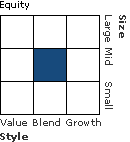| Columbia VP Select Mid Cap Value 1 |
|
 |
|
| Release date as of 2025-09-30. Data on page is subject to change. |
|
|
Overall Morningstar
Rating™
|
| What is this?
|
|
 |
| As of 2025-09-30 |
|
Out of 378
Mid-Cap Value Funds
|
|
|
|
|
|
| Total Fund Assets ($ Mil) |
| 252.52 |
|
|
|
| Investment Objective & Strategy |
|
| The investment seeks to provide shareholders with long-term growth of capital.
|
|
| Under normal circumstances, the fund invests at least 80% of its net assets (including the amount of any borrowings for investment purposes) in equity securities of medium-sized companies. It may invest up to 25% of its net assets in foreign investments. The fund normally invests in common stocks and also may invest in real estate investment trusts. It may from time to time emphasize one or more sectors in selecting its investments, including the financial services sector. |
|
|
| Morningstar Category: Mid-Cap Value |
|
| Some mid-cap value portfolios focus on medium-size companies while others land here because they own a mix of small-, mid-, and large-cap stocks. All look for U.S. stocks that are less expensive or growing more slowly than the market. Stocks in the middle 20% of the capitalization of the U.S. equity market are defined as mid-cap. Value is defined based on low valuations (low price ratios and high dividend yields) and slow growth (low growth rates for earnings, sales, book value, and cash flow).
|
|
|
| Mid Cap Funds: The securities of companies with market capitalizations below $10 billion may be more volatile and less liquid than the securities of larger companies. |
|
|
| % of Net Assets |
 |
U.S. Stocks |
96.3 |
 |
Non-U.S. Stocks |
2.9 |
 |
Bonds |
0.0 |
 |
Cash |
0.9 |
 |
Other |
0.0 |
|
|
 |
| Data through 2025-09-30 |
|
|
|
|
| Morningstar Equity Sectors |
|
|
|
% of Stocks |
 |
Cyclical |
40.44 |
 |
Basic Materials |
3.99 |
 |
Consumer Cyclical |
10.14 |
 |
Financial Services |
17.11 |
 |
Real Estate |
9.20 |
|
|
|
 |
Sensitive |
38.96 |
 |
Communication Services |
4.19 |
 |
Energy |
5.55 |
 |
Industrials |
16.26 |
 |
Technology |
12.96 |
|
|
|
 |
Defensive |
20.59 |
 |
Consumer Defensive |
5.08 |
 |
Healthcare |
7.86 |
 |
Utilities |
7.65 |
|
| Data through 2025-09-30 |
|
|
| Total Number of Stock Holdings |
48 |
| Total Number of Bond Holdings |
0 |
| % of Net Assets in Top 10 Holdings |
30.20 |
|
|
| Turnover % |
(as of 2024-12-31) |
7.00 |
| 30 Day SEC Yield % |
--- |
|
|
Sector |
P/E |
% of Net
Assets
|
 |
 |
 |
 |
 |
 |
Corning Inc |
 |
57.87 |
3.87 |
|
ITT Inc |
 |
31.12 |
3.28 |
|
Welltower Inc |
 |
--- |
3.25 |
|
Entergy Corp |
 |
23.66 |
3.24 |
|
Marathon Petroleum Corp |
 |
28.77 |
3.19 |
 |
|
Popular Inc |
 |
--- |
2.85 |
|
Ameren Corp |
 |
22.58 |
2.76 |
|
AMETEK Inc |
 |
31.28 |
2.67 |
|
Quest Diagnostics Inc |
 |
20.63 |
2.59 |
|
CACI International Inc Class A |
 |
24.90 |
2.50 |
 |
|
 |
|
|
|
|
|
| Foreign Securities, Loss of Money, Not FDIC Insured, Value Investing, Active Management, Issuer, Market/Market Volatility, Industry and Sector Investing, Portfolio Diversification, Mid-Cap, Financials Sector, Real Estate/REIT Sector |
|
| Show Risk Definitions |
|
|
| Inception Date: 2010-05-03 |
|
| Kari L. Montanus (2018-05-01) |
|
| Kari Montanus is a portfolio manager on the Columbia Focused Value Team at Columbia Threadneedle Investments. Ms. Montanus joined one of the Columbia Threadneedle Investments legacy firms in 2003. Previously, she worked for Goldman Sachs & Co. as a vice president of investment research. Prior to that, she was an associate analyst of equity research for Morgan Stanley Dean Witter & Co. and for Morgan Stanley & Company in their Tokyo, Japan office. Ms. Montanus received a B.A. in international relations from Stanford University and an MBA in finance from The Wharton School, University of Pennsylvania. |
|
| Jonas Patrikson (2014-06-25) |
|
| Jonas Patrikson is a portfolio manager for Columbia Threadneedle Investments. Mr. Patrikson joined one of the Columbia Threadneedle Investments legacy firms in 2004. Previously, Mr. Patrikson served as a senior research analyst at Nordberg Capital and as an investment manager in Sweden working for SIF and Svenska Kreditforsakrings AB. He has been a member of the investment community since 1990. Mr. Patrikson holds a B.A. in Finance and Accounting from University of Linkoping, Sweden. In addition, he holds the Chartered Financial Analyst® designation and is a member of the CFA Society of Portland. |
|
|
|
| Columbia Mgmt Investment Advisers, LLC |
|
|
|
|
|
|
|
|

© Copyright 2025 Morningstar, Inc. All rights reserved. Morningstar, the Morningstar logo, Morningstar.com, Morningstar Tools are either trademark or service marks of Morningstar, Inc. The information contained herein: (1) is proprietary to Morningstar and/or its content providers; (2) may not be copied or distributed; and (3) is not warranted to be accurate, complete or timely. Neither Morningstar nor its content providers are responsible for any damages or any losses arising from any use of information. Past performance is no guarantee of future performance. |
|
Past performance is no guarantee of future results.
Returns will vary and shares may be worth more or less than their original cost when sold.
|
|





















